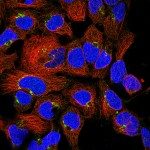Link to Pubmed [PMID] – 31625188
Link to DOI – 10.15252/embj.2018101230
EMBO J 2019 12; 38(23): e101230
Tunneling nanotubes (TNTs) are actin-based transient tubular connections that allow direct communication between distant cells. TNTs play an important role in several physiological (development, immunity, and tissue regeneration) and pathological (cancer, neurodegeneration, and pathogens transmission) processes. Here, we report that the Wnt/Ca2+ pathway, an intracellular cascade that is involved in actin cytoskeleton remodeling, has a role in TNT formation and TNT-mediated transfer of cargoes. Specifically, we found that Ca2+ /calmodulin-dependent protein kinase II (CaMKII), a transducer of the Wnt/Ca2+ pathway, regulates TNTs in a neuronal cell line and in primary neurons. We identified the β isoform of CaMKII as a key molecule in modulating TNT formation and transfer, showing that this depends on the actin-binding activity of the protein. Finally, we found that the transfer of vesicles and aggregated α-synuclein between primary neurons can be regulated by the activation of the Wnt/Ca2+ pathway. Our findings suggest that Wnt/Ca2+ pathway could be a novel promising target for therapies designed to impair TNT-mediated propagation of pathogens.


